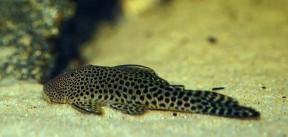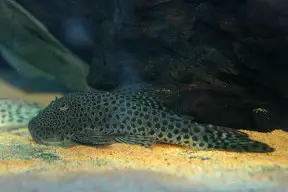Chaetostoma sp.
Spotted Bulldog Plec, L187a
Classification
Loricariidae
Distribution
Colombia.
Habitat
Fast-flowing mountain waters with rocky substrates. These streams typically have very clear, cool water and are quite high in dissolved minerals and salts.
Maximum Standard Length
4.8″ (12cm).
Aquarium SizeTop ↑
A pair could be kept in a tank measuring 30″ x 12″ x 12″ (75cm x 30cm x 30cm) – 67.5 litres. Larger quarters would be required for a group.
Maintenance
To appreciate it at its best, it really should be kept in a biotope setup, consisting of a sandy substrate over which is scattered lots of smooth pebbles and rocks of varying sizes. A powerhead at one end of the tank will provide the necessary water movement and oxygenation. Plants don’t tend to do so well under these conditions, but you could try the hardier species such as Anubias and java fern, and these may survive for a while. If kept in a more general setup, it won’t do well in very warm or poorly-oxygenated water.
Water Conditions
Temperature: 68-73°F (20-23°F)
pH: 6.8-7.8. Prefers it slightly on the alkaline side of neutral.
Hardness: 8-25°H
Diet
It’s omnivorous, so offer plenty of greenstuffs, such as blanched spinach, courgette and cucumber slices, etc. and live and frozen foods such as bloodworm and brine shrimp. It will also take algae wafers and other dried foods.
Behaviour and CompatibilityTop ↑
Despite being amicable towards other fish, its specialist requirements mean tankmates must be chosen with care. Good choices include characins, other Loricariids, reophilic cichlid species such as Retroculus or the African Steatocranus and many cyprinids. It’s territorial with conspecifics but provided each has a rock it can call home, a few of these can usually be housed together.
Sexual Dimorphism
Males tend to be slimmer than females, and develop much broader heads as they mature. They also have noticeably larger pectoral fins than females.
Reproduction
Not known to have occured in the hobby, but the closely related L187b has been spawned a few times, and spawning is likely to be fairly similar here. In L187b, the males each defend a rock, and may dig a cave under it if the rock isn’t of the correct design. The eggs are laid within this cave, and the male tends them until they hatch, fanning them with his enlarged pectoral fins and defending against intruders. They hatch in 7-10 days and the fry feed first from their yolk sacs. These are quite small, however, and they’ll be actively seeking food 2 or 3 days later. They will quite happily graze on the same foods as the parents, but these must be provided constantly for the initial period, and small, daily water changes are required, as they’re very sensitive to water quality.
If you’re having trouble spawning these, try conducting a large (50-70%) water change with cool water, simulating the infux of colder water the rainy season brings in nature. Repeat every few days and the fish may spawn.
NotesTop ↑
Also known popularly as the rubbernose plecs, Chaetostoma species are seen for sale quite often these days. This is one of the more commonly seen, and provided its needs are adequately met, is a very hardy little fish. There’s a bit of mystery surrounding its true identity, hence the species name, and it’s sometimes misidentified in shops. The true L187 is currently known as Chaetostoma pearsei, and is a white-spotted fish.
When buying Loricariids such as this always check the fish has a rounded belly and that its eyes aren’t sunken, as these are classic signs of emaciation in newly imported specimens.



